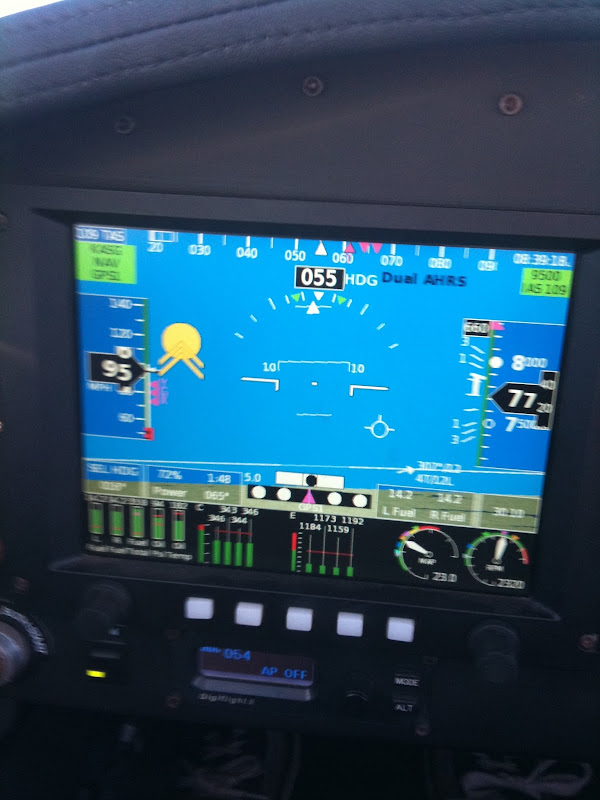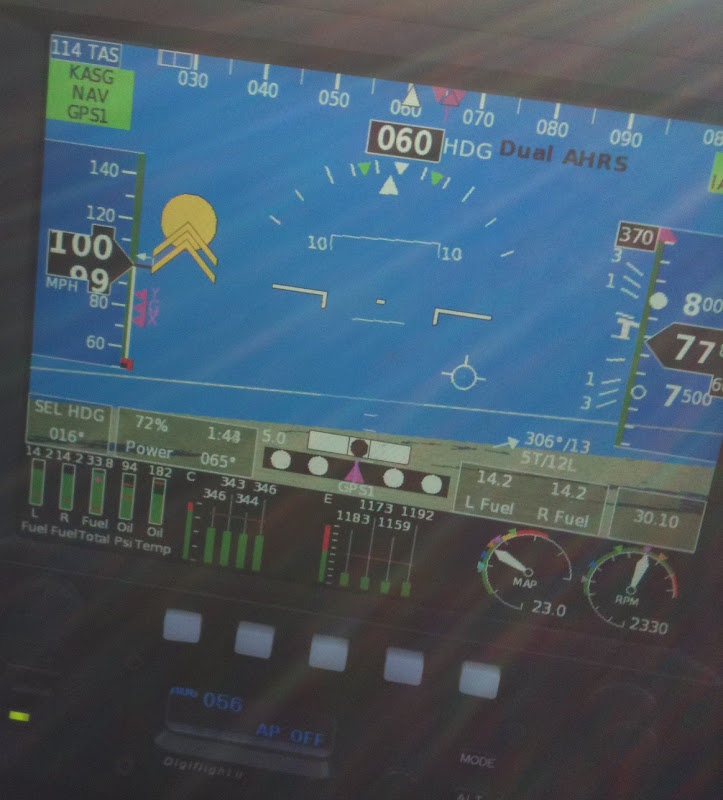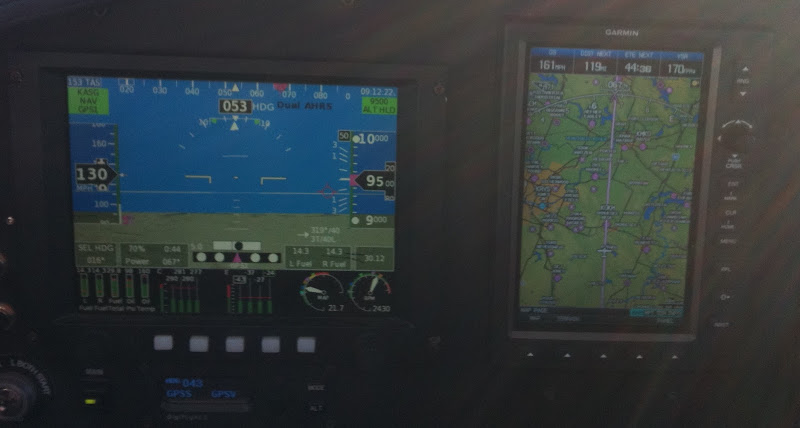RVbySDI
Well Known Member
I have posted some pictures below along with a brief discussion concerning the engine performance on my 9A. I feel compelled to do so because the more I fly this airplane; the more impressed I am with its performance. The performance of any aircraft has many contributing components that make it what it is. I know there are many topics I could discuss concerning the 9A design and the great performance this airplane provides. However, I would like to confine this discussion today to the engine performance I am seeing with my airplane and specifically to the cooling aspects of running it in the various stages of flight.
I built my 9A with the ECI IO-340. This is a stroked IO-320, same bore as a 320 but longer stroke. The firewall forward setup also includes Vetterman 4-pipe exhaust, forward facing cold air induction, one Slick mag and one Lightspeed Plasma III electronic ignition. The engine is turning a Catto 3-blade 68 X 72 fixed pitch prop. I chose this engine and prop combination after many discussions with Richard & Steve Fowler at America?s Aircraft Engines during several visits at Oshkosh and Sun n Fun and further discussions with Craig Catto of Catto Propellers. All the information coming out of ECI proved to me this was a perfect engine and prop setup for the RV9A. My experience is proving that belief to be justified.
So to set the stage for this discussion the pictures below show real world information on a flight this past Saturday, October 15, 2011. In the first picture (sorry for the blurry picture), the instruments are displaying a climb out to 9500' from my home airport heading to Springdale, AR. This climb out picture shows me to be around 7700'. This means I had been climbing out for around 6-7 minutes to that point.

What I would like to focus on with this picture, and the next one, are the engine temperatures displayed at the bottom of the screen. This section of the screen shows most of the vital engine information.
Just to keep the information fresh remember I am climbing out at 7700? altitude. My airspeed is around 109-115 MPH (all speed indications are using statute MPH) and climbing anywhere from 370-660 FPM. Ok, before everyone starts ragging me about the climb out rate just note this; I was somewhat distracted when I snapped these two pictures. Because of that I let the climb angle relax while I took the pictures. I actually can and do see higher climb out rates, even at this altitude. That is my story and I am sticking to it! Well, anyway. . .

Getting back to the discussion about the engine performance, note the numbers for the CHT's and EGT?S. The CHT?s were between 343-346, the EGT'S were between 1159-1192. Also note the oil temp reading of 182 degrees. Ok, here is the point of my discussion. During this and all other climb outs I do not run the mixture FULL RICH. As stated above, I am running a fixed pitch prop. Because of this, I cannot gain full RPM on takeoff or climb out at FULL RICH. I can remedy this somewhat by leaning the mixture out during climb. This allows me to see around 2300-2400 RPM but I still cannot get the full RPM this engine can put out. As you can see on these pictures, I am getting 2330 RPM at 23.0 MAP which is getting me approximately 70-72% HP (this % HP is derived from tables provided by ECI and GRT).
Now, here is where my discussion gets to the point I wanted to make. I have had people bring to my attention the issue of leaning my engine out during climb out. The concern is that during such high power output the pistons need as much cooling as possible to keep them cool. Fuel flowing through the cylinders is the traditional way of cooling during climb out. The consensus is there is not sufficient enough air flow through the baffling and down through the cylinders to effectively cool the cylinders. Therefore, one should keep as much fuel flowing to these cylinders in order to provide adequate cooling.
Ok, I can understand this stance. I really do not have enough experience to dispute any sage who stands by this philosophy. Except. . . I do have my first hand experience with THIS engine. And what I am finding out about THIS engine is that it is a very cool running engine. Now to be honest, it is a young engine. I only have approx. 150 hours TT on it. Never the less, it truly is a cool engine (pun intended)! In most every situation it remains very cool. Now I don?t know if that is because my baffling is installed very well and that I have good air flow or if the metallurgic make up of this engine is such that it is efficiently dissipating heat, whatever the reason it is working very well.
With my fixed pitch prop not producing full HP at climb out I lean the engine off of FULL RICH in order to increase the RPM and hopefully gain more thrust. On this day I would estimate I had the red knob about 1/2 way out. Even with fairly aggressive leaning (Although still ROP!) I was still seeing EGT temps that were well below peak EGT?s (typically 1400-1410). In this case they were 208-248 below peak at 1159-1192.
Those EGT numbers are my point! Even with my somewhat aggressive leaning during climb out I still see very cool EGT temperatures. And less, someone reminds me, no I am not forgetting about the CHT temps. They are indeed also staying cool. Remember in this climb out they were still staying between 343-346 degrees. In fact, what is even more interesting is the tight span between cylinders. During all phases of flight I am finding all four cylinders are staying within just a few degrees of each other. I believe this is just as important an indicator of engine health as temperature. With all cylinders staying within a tight range I believe they are getting equal cooling across the entire spectrum of performance.
Ok, one last comment about this particular flight. I hate to just talk about climb out as I feel the true strength of my airplane is in its cruise performance. Now I know there are a great many speed merchants in the RV world that will look at my numbers and talk about how much more speed I can get out of this airplane. I hear you guys. I believe you. I know this airplane can travel much faster than I am currently flying it. However, with the expense of fuel today and the fact that this airplane as I currently fly it is already much faster than any other Cessna 172 or Cherokee I have ever flown, I am very content at this point to pull the mixture back and conserve fuel while still seeing 150-160 MPH TAS. I am perfectly content to fly for 3 hours and come down two states away. That is very WAY COOL!

Ok, so this third picture is showing the readouts at cruise during the same flight as above. This is a very typical picture of what I often see at cruise. CHT's 277-290, EGT's now running LOP -24 to -43 (look closely at the EGT numbers, the white box is the first cylinder to go lean; the green box is the last cylinder to go lean). Oil temperature now down to 160 degrees from 182 at climb out. I did not capture fuel flow with this picture but it is at 7 gph at this point. So, I was cruising 153 MPH TAS (161 MPH ground speed) at 9500' burning 7 gph (22.9 mpg)!
So, this is my post. Sorry to be so long winded. I look forward to hearing any and all comments, complaints or corrections.
I built my 9A with the ECI IO-340. This is a stroked IO-320, same bore as a 320 but longer stroke. The firewall forward setup also includes Vetterman 4-pipe exhaust, forward facing cold air induction, one Slick mag and one Lightspeed Plasma III electronic ignition. The engine is turning a Catto 3-blade 68 X 72 fixed pitch prop. I chose this engine and prop combination after many discussions with Richard & Steve Fowler at America?s Aircraft Engines during several visits at Oshkosh and Sun n Fun and further discussions with Craig Catto of Catto Propellers. All the information coming out of ECI proved to me this was a perfect engine and prop setup for the RV9A. My experience is proving that belief to be justified.
So to set the stage for this discussion the pictures below show real world information on a flight this past Saturday, October 15, 2011. In the first picture (sorry for the blurry picture), the instruments are displaying a climb out to 9500' from my home airport heading to Springdale, AR. This climb out picture shows me to be around 7700'. This means I had been climbing out for around 6-7 minutes to that point.

What I would like to focus on with this picture, and the next one, are the engine temperatures displayed at the bottom of the screen. This section of the screen shows most of the vital engine information.
Just to keep the information fresh remember I am climbing out at 7700? altitude. My airspeed is around 109-115 MPH (all speed indications are using statute MPH) and climbing anywhere from 370-660 FPM. Ok, before everyone starts ragging me about the climb out rate just note this; I was somewhat distracted when I snapped these two pictures. Because of that I let the climb angle relax while I took the pictures. I actually can and do see higher climb out rates, even at this altitude. That is my story and I am sticking to it! Well, anyway. . .

Getting back to the discussion about the engine performance, note the numbers for the CHT's and EGT?S. The CHT?s were between 343-346, the EGT'S were between 1159-1192. Also note the oil temp reading of 182 degrees. Ok, here is the point of my discussion. During this and all other climb outs I do not run the mixture FULL RICH. As stated above, I am running a fixed pitch prop. Because of this, I cannot gain full RPM on takeoff or climb out at FULL RICH. I can remedy this somewhat by leaning the mixture out during climb. This allows me to see around 2300-2400 RPM but I still cannot get the full RPM this engine can put out. As you can see on these pictures, I am getting 2330 RPM at 23.0 MAP which is getting me approximately 70-72% HP (this % HP is derived from tables provided by ECI and GRT).
Now, here is where my discussion gets to the point I wanted to make. I have had people bring to my attention the issue of leaning my engine out during climb out. The concern is that during such high power output the pistons need as much cooling as possible to keep them cool. Fuel flowing through the cylinders is the traditional way of cooling during climb out. The consensus is there is not sufficient enough air flow through the baffling and down through the cylinders to effectively cool the cylinders. Therefore, one should keep as much fuel flowing to these cylinders in order to provide adequate cooling.
Ok, I can understand this stance. I really do not have enough experience to dispute any sage who stands by this philosophy. Except. . . I do have my first hand experience with THIS engine. And what I am finding out about THIS engine is that it is a very cool running engine. Now to be honest, it is a young engine. I only have approx. 150 hours TT on it. Never the less, it truly is a cool engine (pun intended)! In most every situation it remains very cool. Now I don?t know if that is because my baffling is installed very well and that I have good air flow or if the metallurgic make up of this engine is such that it is efficiently dissipating heat, whatever the reason it is working very well.
With my fixed pitch prop not producing full HP at climb out I lean the engine off of FULL RICH in order to increase the RPM and hopefully gain more thrust. On this day I would estimate I had the red knob about 1/2 way out. Even with fairly aggressive leaning (Although still ROP!) I was still seeing EGT temps that were well below peak EGT?s (typically 1400-1410). In this case they were 208-248 below peak at 1159-1192.
Those EGT numbers are my point! Even with my somewhat aggressive leaning during climb out I still see very cool EGT temperatures. And less, someone reminds me, no I am not forgetting about the CHT temps. They are indeed also staying cool. Remember in this climb out they were still staying between 343-346 degrees. In fact, what is even more interesting is the tight span between cylinders. During all phases of flight I am finding all four cylinders are staying within just a few degrees of each other. I believe this is just as important an indicator of engine health as temperature. With all cylinders staying within a tight range I believe they are getting equal cooling across the entire spectrum of performance.
Ok, one last comment about this particular flight. I hate to just talk about climb out as I feel the true strength of my airplane is in its cruise performance. Now I know there are a great many speed merchants in the RV world that will look at my numbers and talk about how much more speed I can get out of this airplane. I hear you guys. I believe you. I know this airplane can travel much faster than I am currently flying it. However, with the expense of fuel today and the fact that this airplane as I currently fly it is already much faster than any other Cessna 172 or Cherokee I have ever flown, I am very content at this point to pull the mixture back and conserve fuel while still seeing 150-160 MPH TAS. I am perfectly content to fly for 3 hours and come down two states away. That is very WAY COOL!

Ok, so this third picture is showing the readouts at cruise during the same flight as above. This is a very typical picture of what I often see at cruise. CHT's 277-290, EGT's now running LOP -24 to -43 (look closely at the EGT numbers, the white box is the first cylinder to go lean; the green box is the last cylinder to go lean). Oil temperature now down to 160 degrees from 182 at climb out. I did not capture fuel flow with this picture but it is at 7 gph at this point. So, I was cruising 153 MPH TAS (161 MPH ground speed) at 9500' burning 7 gph (22.9 mpg)!
So, this is my post. Sorry to be so long winded. I look forward to hearing any and all comments, complaints or corrections.




